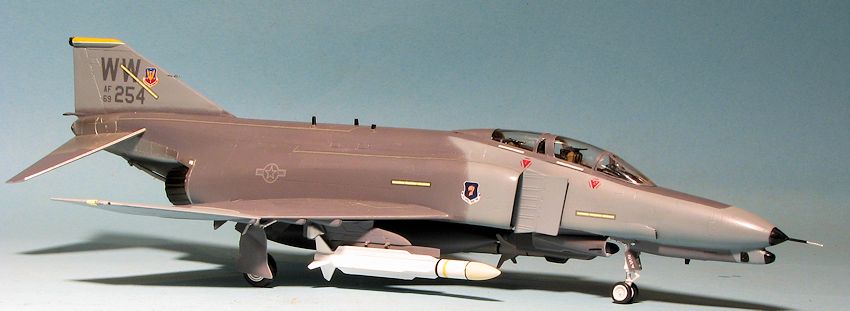
Hasegawa 1/72 F-4G 'Wild Weasel'
| KIT #: | 04108 |
| PRICE: | $10.00 without decals from a vendor back in the early 2000's |
| DECALS: | Two options, according to the instructions |
| REVIEWER: | Scott Van Aken |
| NOTES: | 1991 'Desert Storm' boxing |

| HISTORY |
The McDonnell Douglas F-4 Phantom II is a tandem, two-seat, twin-engine, all-weather, long-range supersonic jet interceptor fighter/fighter-bomber originally developed for the United States Navy by McDonnell Aircraft. It first entered service in 1960 with the U.S. Navy. Proving highly adaptable, it was also adopted by the U.S. Marine Corps and the U.S. Air Force, and by the mid-1960s had become a major part of their respective air wings.
The Phantom is a large fighter with a top speed of over Mach 2.2. It can carry over 18,000 pounds (8,400 kg) of weapons on nine external hardpoints, including air-to-air missiles, air-to-ground missiles, and various bombs. The F-4, like other interceptors of its time, was designed without an internal cannon. Later models incorporated a M61 Vulcan rotary cannon. Beginning in 1959 it set 15 world records for in-flight performance, including an absolute speed record, and an absolute altitude record.
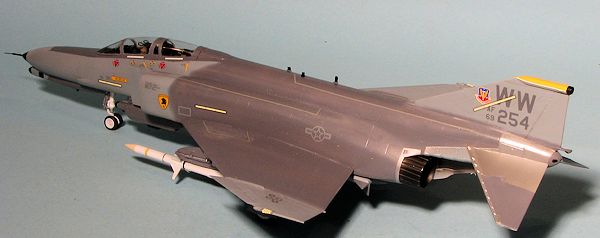 During the Vietnam War the F-4 was used extensively; it served
as the principal air superiority fighter for both the Navy and Air Force, and
became important in the ground-attack and reconnaissance roles late in the war.
The Phantom has the distinction of being the last U.S. fighter flown to attain
ace status in the 20th century. During the Vietnam War the USAF had one pilot
and two weapon systems officers (WSOs), and the US Navy one pilot and one radar
intercept officer (RIO), achieve five aerial kills against other enemy fighter
aircraft and become aces in air-to-air combat. The F-4 continued to form a major
part of U.S. military air power throughout the 1970s and 1980s, being gradually
replaced by more modern aircraft such as the F-15 Eagle and F-16 in the U.S. Air
Force; the Grumman F-14 Tomcat and F/A-18 Hornet in the U.S. Navy; and the
F/A-18 in the U.S. Marine Corps.
During the Vietnam War the F-4 was used extensively; it served
as the principal air superiority fighter for both the Navy and Air Force, and
became important in the ground-attack and reconnaissance roles late in the war.
The Phantom has the distinction of being the last U.S. fighter flown to attain
ace status in the 20th century. During the Vietnam War the USAF had one pilot
and two weapon systems officers (WSOs), and the US Navy one pilot and one radar
intercept officer (RIO), achieve five aerial kills against other enemy fighter
aircraft and become aces in air-to-air combat. The F-4 continued to form a major
part of U.S. military air power throughout the 1970s and 1980s, being gradually
replaced by more modern aircraft such as the F-15 Eagle and F-16 in the U.S. Air
Force; the Grumman F-14 Tomcat and F/A-18 Hornet in the U.S. Navy; and the
F/A-18 in the U.S. Marine Corps.
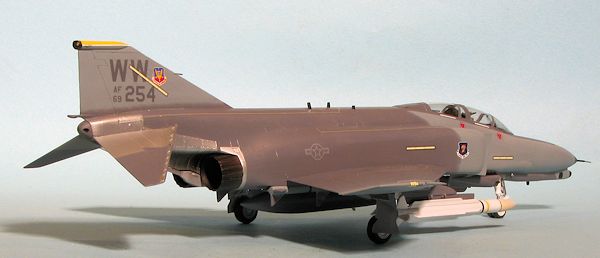 The F-4 Phantom II remained in use by the U.S. in the
reconnaissance and Wild Weasel (suppression of enemy air defenses) roles in the
1991 Gulf War, finally leaving service in 1996. It was also the only aircraft
used by both U.S. flight demonstration teams: the USAF Thunderbirds (F-4E) and
the US Navy Blue Angels (F-4J).[
The F-4 was also operated by the armed forces of 11 other nations. Israeli
Phantoms saw extensive combat in several Arab–Israeli conflicts, while Iran used
its large fleet of Phantoms in the Iran–Iraq War. Phantoms remain in front line
service with several countries, and in use as an unmanned target in the U.S. Air
Force. However, it is soon to be retired from the drone force by the QF-16C as
the diminishing number of Phantom airframes is used up. Phantom production ran
from 1958 to 1981, with a total of 5,195 built, making it the most numerous
American supersonic military aircraft.
The F-4 Phantom II remained in use by the U.S. in the
reconnaissance and Wild Weasel (suppression of enemy air defenses) roles in the
1991 Gulf War, finally leaving service in 1996. It was also the only aircraft
used by both U.S. flight demonstration teams: the USAF Thunderbirds (F-4E) and
the US Navy Blue Angels (F-4J).[
The F-4 was also operated by the armed forces of 11 other nations. Israeli
Phantoms saw extensive combat in several Arab–Israeli conflicts, while Iran used
its large fleet of Phantoms in the Iran–Iraq War. Phantoms remain in front line
service with several countries, and in use as an unmanned target in the U.S. Air
Force. However, it is soon to be retired from the drone force by the QF-16C as
the diminishing number of Phantom airframes is used up. Phantom production ran
from 1958 to 1981, with a total of 5,195 built, making it the most numerous
American supersonic military aircraft.
As a note, the F-4G aircraft were all converted F-4Es in the 69-xxxx serial sequence and was also the last combat Phantom variant flown by the regular USAF and ANG. Most if not all of them are and will be expended as drones.
| THE KIT |
Following the success of Fujimi's Phantom line, Hasegawa decided to go ahead and add this series of aircraft to their catalogue in the early 1990s. They have produced a rather large number of these kits and they take insert madness to a new level having more inserts than probably any other 1/72 aircraft line.
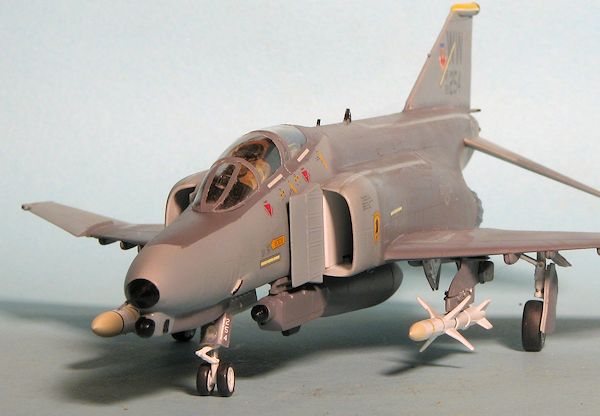 The kit has been molded a bunch of times and the main airframe parts are all
basically the same in all the kits. There are differences in the nose, wing
tips, burner cans and fin tips that are taken care of by inserts. The F-4G is
basically an F-4E kit with an additional sprue that includes the revised nose.
The cockpit is just the same as all their USAF Phantom boxings and while the
bang seats are nice, for my build, I got a set of Quickboost resin seats. The
canopy is multisectional so you can display the interior.
The kit has been molded a bunch of times and the main airframe parts are all
basically the same in all the kits. There are differences in the nose, wing
tips, burner cans and fin tips that are taken care of by inserts. The F-4G is
basically an F-4E kit with an additional sprue that includes the revised nose.
The cockpit is just the same as all their USAF Phantom boxings and while the
bang seats are nice, for my build, I got a set of Quickboost resin seats. The
canopy is multisectional so you can display the interior.
For the F-4G, like the later F-4Es, there are leading edge slats so the wings need the holes in the lower section opened to accept the slat actuators. The kit includes nicely done landing gear and has both wing and centerline tanks. There are weapons racks for Sidewinders on the inner pylons, but no weapons. Since the F-4G carried anti-radiation missiles, these racks are not appropriate, though the pylons are. Hasegawa has the proper missiles in their weapons sets. The kit decals are supposed to be for two planes: one is the boss bird of the 37th TFW in the Hill Grey II scheme while the other is a shark mouth aircraft of the 23 TFS/52 TFW in the Euro I wrap scheme.
| CONSTRUCTION |
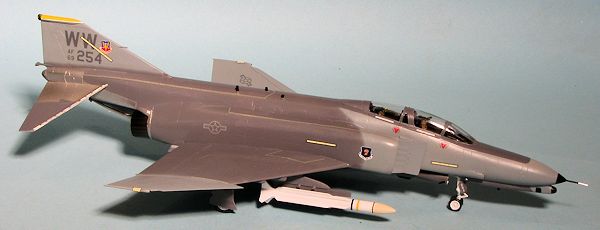 Hasegawa does the entire cockpit section separately from the rest of the
fuselage so I started my build by gluing the fuselage halves together and
sticking on the insert for the fin tip and the doors for the flare ejector area.
I also glued the centerline tank and the nose section. This kit comes with the
proper F-15 style centerline tank.
Hasegawa does the entire cockpit section separately from the rest of the
fuselage so I started my build by gluing the fuselage halves together and
sticking on the insert for the fin tip and the doors for the flare ejector area.
I also glued the centerline tank and the nose section. This kit comes with the
proper F-15 style centerline tank.
After brush painting the interior bits in dark gull grey, I started assembling them. The down side to buying a Hasegawa 1/72 kit without decals is that you don't have any instrument decals so the blank faces of the various panels were simply painted black. Of course, this would be an opportunity to use an Eduard color zoom set, however, they don't do one for the F-4G and the instrument panels are different enough to make using one for another variant a bit of a waste of time and money. Fortunately, a kind reader sent me what I needed and after a bit of a delay, those were installed and the build resumed.
| COLORS & MARKINGS |
 Thankfully I had the very nice Fox One sheet 72-011 'Wild
Weasels over Iraq' that had a goodly number of options. For this one, I decided
to do a 35 TFW plane as based at George AFB. This wing disbanded in March of
1992 and the base subsequently closed. Most of the aircraft went to the 57th FW
at Nellis AFB (in mid-late 1992, TAC changed to ACC and all units had the word
'Tactical' removed from their designations). You can see George AFB used in many TV
shows and movies that need a military installation,
flight line and hangars. I also had to scrounge up a sheet of walkways, and had
some on the very old Superscale 72-484 sheet that were usable.
Thankfully I had the very nice Fox One sheet 72-011 'Wild
Weasels over Iraq' that had a goodly number of options. For this one, I decided
to do a 35 TFW plane as based at George AFB. This wing disbanded in March of
1992 and the base subsequently closed. Most of the aircraft went to the 57th FW
at Nellis AFB (in mid-late 1992, TAC changed to ACC and all units had the word
'Tactical' removed from their designations). You can see George AFB used in many TV
shows and movies that need a military installation,
flight line and hangars. I also had to scrounge up a sheet of walkways, and had
some on the very old Superscale 72-484 sheet that were usable.
I wanted one of the planes with some color in it and
one of them was 'stock' without unit markings/color removed for the deployment.
I have a photo of the plane I am doing (69-0254) that was taken in September of
1991, however, it was with the 562 TFS vice the 561 TFS markings from February
1992 as provided on the sheet. The only real difference is the squadron badge
and the fin tip color. As you can s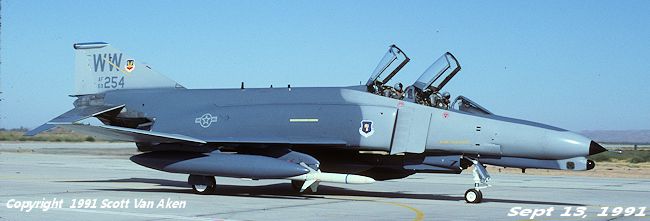 ee, the plane is very clean. Just to finish
the story, when the 35th TFW disbanded, the WW tail code went to the 190 TFS,
Idaho ANG until they got out of the Phantom business and went over to A-10s. The
WW code eventually went to Misawa as is currently on F-16Cs. The 561st went to Nellis
AFB and was part of the 57th FW until the USAF got out the Phantom Wild Weasel
business entirely. Probably more than you wanted to know, but thought it might
be interesting.
ee, the plane is very clean. Just to finish
the story, when the 35th TFW disbanded, the WW tail code went to the 190 TFS,
Idaho ANG until they got out of the Phantom business and went over to A-10s. The
WW code eventually went to Misawa as is currently on F-16Cs. The 561st went to Nellis
AFB and was part of the 57th FW until the USAF got out the Phantom Wild Weasel
business entirely. Probably more than you wanted to know, but thought it might
be interesting.
Anyway, I first sprayed on the FS 36320 using Testors Model Master enamels. I then went back and sprayed the FS 36118, this being in a Polly Scale acrylic. This, of course, was just the beginning. The nose and canopy area are masked so that had to be done and more painting done. You'll notice when looking at a row of Hill Grey II F-4s that the scheme isn't exactly the same on all of them. In this case, the lighter grey goes rather far back on the intakes and rear canopy area. The darker grey does not fully cover the nose sensor area. All of this had to be duplicated as best I could. I also painted the fin tip white, then yellow and masked it.
| FINAL CONSTRUCTION |
With most of the paint in place, I brush painted the wheel wells with Citadel white and attached the landing gear. This is to allow the kit to stand on something when applying the gloss coat before decals. Once that was done, the gloss coat was applied and I then attached the kit wheels. The bits to be painted black were handled save for the tail antenna.
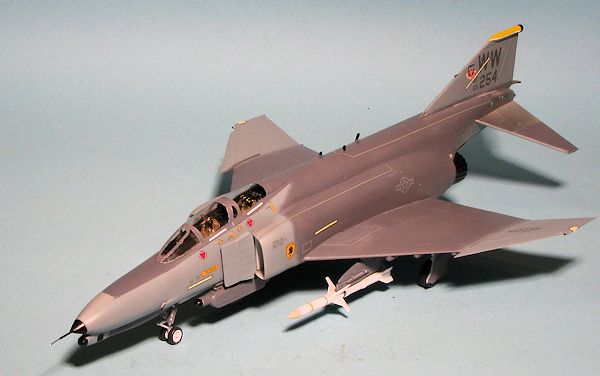 then started applying the decals. While this was going on, I
built up the pylons. These the large chaff/flare dispensers attached as well as
the anti-sway braces. The missile racks were then glued in place after a bit of
trimming to get them to fit flush. Each of these pylons consisted of eight parts
plus the missile.
then started applying the decals. While this was going on, I
built up the pylons. These the large chaff/flare dispensers attached as well as
the anti-sway braces. The missile racks were then glued in place after a bit of
trimming to get them to fit flush. Each of these pylons consisted of eight parts
plus the missile.
Then I went back and applied the gear doors and hinges. These Phantoms also have a lot of small antennas so those were attached as well. I then put some stripes on the white painted missiles and attached those. The stripe sequence is bogus as I do not have all the colors and widths required in my stripes stash. I then scrounged some Sparrows from the 'Phantom bits' box, painted them up and glued them in place. The final touch up painting took longer than I'd have thought, but eventually it was done. The model was given some semi-gloss clear to cut back on some of the shine, the exhaust, centerline tank, and stabs glued on, the masking removed and I was done.
| CONCLUSIONS |
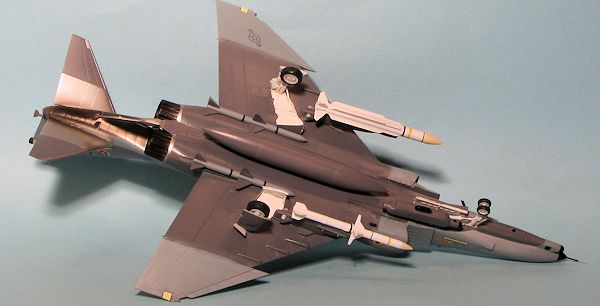 Let me start by saying that I really like the Hasegawa
Phantoms, but they take me a long time to build. This is as much due to all the
inserts, weapons and fiddly bits as anything. I have now built three F-4Gs,
covering the units in Germany, Philippines and now from George AFB. Those
previous kits were Testors/Italeri versions. The only other operators were at
Nellis and at Boise. Reno got one plane and it was painted in unit markings, but
it was returned a few months later when it was decided that they would not get
the G model. It spent most of its time there in the hangar.
Let me start by saying that I really like the Hasegawa
Phantoms, but they take me a long time to build. This is as much due to all the
inserts, weapons and fiddly bits as anything. I have now built three F-4Gs,
covering the units in Germany, Philippines and now from George AFB. Those
previous kits were Testors/Italeri versions. The only other operators were at
Nellis and at Boise. Reno got one plane and it was painted in unit markings, but
it was returned a few months later when it was decided that they would not get
the G model. It spent most of its time there in the hangar.
Anyway, until something better comes along, this is pretty much the best F-4G in this scale. It doesn't get released very often so can be somewhat difficult to locate. If you see one at a reasonable price, you should get your hands on it.
| REFERENCES |
http://en.wikipedia.org/wiki/F-4_Phantom_II
July 2013
Thanks to me for the kit and to Rex for the instrument decals. Though they are no longer in business, thanks to Fox One for the decals.
If you would like your product reviewed fairly and fairly quickly, please contact the editor or see other details in the Note to Contributors.